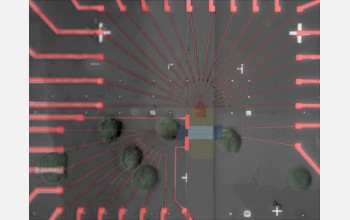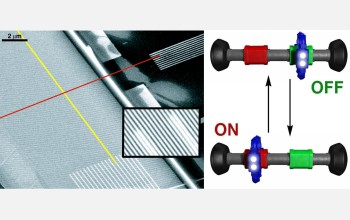All Images
News Release 07-006
Blood-Cell-Sized Memory Device Beats Industry Estimates for Computing Capacity
Nanochip moves molecular computers a step closer
This material is available primarily for archival purposes. Telephone numbers or other contact information may be out of date; please see current contact information at media contacts.

The bluish-grey area in the center of the picture contains the 160,000 bit memory array. The greenish circles nearby are white blood cells.
Credit: Jonathan Green, John Nagarah and Habib Ahmad, California Institute of Technology
Download the high-resolution JPG version of the image. (99 KB)
Use your mouse to right-click (Mac users may need to Ctrl-click) the link above and choose the option that will save the file or target to your computer.

Molecular switches (right) called [2]rotaxanes are made of two interlocking components--a molecular ring encircling a dumbbell-shaped molecule. When the switch is triggered, the ring slides between two locations on the dumbbell to control conductivity. Designed in the UCLA laboratory of J. Fraser Stoddart, the switches store information in an ultra-dense 160-kilobit memory made up of a 400 x 400 grid of nanowires (left).
Credit: J. Fraser Stoddart Supramolecular Chemistry Group, UCLA
Download the high-resolution JPG version of the image. (500 KB)
Use your mouse to right-click (Mac users may need to Ctrl-click) the link above and choose the option that will save the file or target to your computer.


